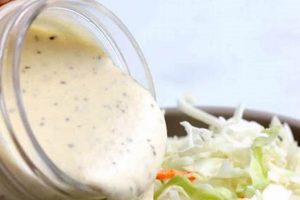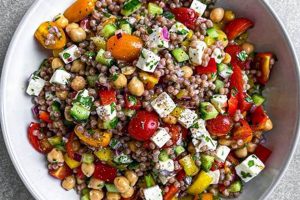A culinary preparation involving cauliflower florets coated in a spiced batter, baked or fried to achieve a tender interior and crispy exterior, then tossed in a tangy and spicy buffalo sauce. This dish offers a plant-based alternative to traditional buffalo chicken wings, appealing to individuals adhering to vegan diets or seeking lighter options. The result is a flavorful appetizer or main course, suitable for various dietary preferences and occasions.
The significance of this particular preparation lies in its ability to provide a satisfying and flavorful experience while remaining entirely plant-based. Benefits include reduced saturated fat and cholesterol compared to meat-based counterparts, as well as increased fiber content from the cauliflower. The adoption of cauliflower as a substitute for meat in buffalo-flavored dishes reflects the growing popularity of plant-based eating and the creative adaptation of classic recipes to meet contemporary dietary needs. Its emergence aligns with broader trends toward healthy and sustainable food choices.
The subsequent sections will delve into the preparation techniques, ingredient considerations, and potential variations for achieving optimal results with this dish. Key elements to be explored include batter consistency, baking versus frying methods, buffalo sauce selection, and serving suggestions to enhance the overall dining experience.
Preparation Enhancement Guidelines
The subsequent points offer insight into refining the preparation process, thereby maximizing flavor and texture.
Tip 1: Batter Adherence. Prior to battering, ensure the cauliflower florets are thoroughly dried. Excess moisture inhibits batter adhesion, resulting in a soggy final product.
Tip 2: Battering Technique. Employ a light, even coating of batter on each floret. Over-battering creates a heavy, doughy texture that detracts from the cauliflower’s natural flavor.
Tip 3: Baking Temperature Optimization. When baking, maintain a consistent oven temperature of approximately 400F (200C). This promotes even cooking and prevents burning. Periodically rotating the baking sheet can further enhance uniformity.
Tip 4: Frying Temperature Regulation. If frying, maintain a consistent oil temperature of 350F (175C). Overcrowding the frying vessel lowers the oil temperature and results in uneven cooking and excessive oil absorption.
Tip 5: Buffalo Sauce Consistency. Prior to tossing the prepared cauliflower, evaluate the buffalo sauce’s consistency. Thicker sauces adhere better to the florets, providing a more pronounced flavor profile.
Tip 6: Serving Temperature. Serve immediately after tossing in the buffalo sauce. Prolonged sitting can lead to a reduction in crispness and a diminished sensory experience.
Tip 7: Spice Level Adjustment. Adjust the amount of hot sauce to suit individual preferences. Consider adding a small amount initially and tasting as the mixture progresses.
Implementing these guidelines will contribute to an enhanced dining experience, characterized by optimal flavor, texture, and overall satisfaction.
The conclusion provides a comprehensive summary of this dish, highlighting its versatility and accessibility within a plant-based culinary framework.
1. Cauliflower Preparation
Proper cauliflower preparation is fundamental to the successful execution of a palatable vegan buffalo cauliflower recipe. The following considerations impact the final texture, flavor adherence, and overall presentation of the dish.
- Floret Size and Uniformity
Consistent floret size ensures even cooking throughout the batch. Irregularly sized florets result in some pieces being undercooked while others are overcooked, compromising the overall texture. A uniform size, approximately 1-1.5 inches in diameter, is recommended.
- Washing and Drying
Thorough washing removes any residual dirt or debris from the cauliflower. However, completely drying the florets post-washing is crucial. Excess moisture inhibits batter adhesion, leading to a soggy, less crispy finished product. Patting the florets dry with paper towels is a standard practice.
- Stem Removal
The tough stems of the cauliflower are generally undesirable in this recipe. Removing them and utilizing only the more tender florets improves the texture and palatability. Leaving stems attached will affect the flavor and texture of the overall result of the recipe.
- Pre-Cooking Considerations
Some recipes suggest briefly blanching or steaming the cauliflower before battering. This pre-cooking step can reduce cooking time in the oven or fryer and result in a more tender interior. However, overcooking at this stage will lead to a mushy final product.
In summary, meticulous cauliflower preparationinvolving uniform size, thorough drying, stem removal, and consideration of pre-cookingdirectly influences the texture, batter adhesion, and overall enjoyment of the vegan buffalo cauliflower recipe. Neglecting these steps can significantly detract from the quality of the final product.
2. Batter Consistency
Batter consistency directly influences the textural outcome of vegan buffalo cauliflower. The batter serves as the primary vehicle for flavor and crispness; its properties dictate how well it adheres to the cauliflower and how it transforms during the cooking process. A batter that is too thick results in a heavy, doughy exterior, obscuring the cauliflower’s natural flavor and hindering crisping. Conversely, a batter that is too thin fails to adequately coat the cauliflower, leading to uneven cooking and a lack of the desired crispy texture. The ideal consistency is a smooth, slightly viscous mixture that clings readily to the florets without dripping excessively. A common example of a well-executed batter achieves a light, golden-brown crust that complements the tender cauliflower beneath.
The composition of the batter also plays a crucial role. Starches, such as cornstarch or tapioca starch, contribute to crispness, while flour provides structure and binding. Liquids, typically non-dairy milk or water, determine the overall viscosity. Adjusting the ratio of these ingredients is essential for achieving the optimal batter consistency. For instance, adding more starch can enhance crispness, while increasing the liquid content can thin out a batter that is too heavy. The practical significance of understanding these relationships is that cooks can modify the batter to suit their preferences or compensate for variations in ingredient quality.
In conclusion, batter consistency is a critical variable in the creation of palatable vegan buffalo cauliflower. The balance between thickness, thinness, and composition significantly impacts the final texture and flavor profile. Achieving the correct consistency requires careful attention to ingredient ratios and an understanding of how each component contributes to the overall result. Mastering this aspect of the recipe elevates the dish from a simple cauliflower preparation to a satisfying and flavorful plant-based alternative. Improper batter consistency is one of the main recipe failure reasons for the vegan buffalo cauliflower.
3. Spice Level
The level of spiciness is a defining characteristic of buffalo-style dishes, and is integral to the overall sensory experience of consuming this plant-based alternative. Controlling the intensity of heat allows for customization to suit diverse palates while maintaining the dish’s signature profile.
- Source of Heat
Hot sauce is the primary contributor to the spiciness. Common brands utilize cayenne peppers as their base, while others incorporate different chili varieties, such as habaneros or ghost peppers, resulting in varying levels of heat. The selection of hot sauce directly dictates the dish’s overall intensity. For instance, a sauce based on cayenne peppers offers a moderate heat, whereas a habanero-based sauce provides a significantly more pronounced effect. Other ingredients, such as chili powder or red pepper flakes, can supplement the hot sauce to further adjust the spiciness.
- Heat Modulation
The intensity can be moderated through various techniques. Dilution with butter (or vegan butter alternatives) and vinegar reduces the concentration of capsaicin, the compound responsible for the sensation of heat. Addition of sweeteners, such as maple syrup or agave nectar, provides a counterpoint to the spice, creating a more balanced flavor profile. The incorporation of dairy-free ranch or blue cheese dressings as dipping sauces further mitigates the heat for those with lower tolerance.
- Regional Variations
Different regions and cultural preferences influence the typical level of spiciness. Some regions favor a more assertive heat, employing higher concentrations of hot sauce or spicier chili varieties. Others prioritize a milder flavor profile, opting for gentler heat sources or emphasizing the sweetness and tanginess of the sauce. Adaptation to local tastes is essential when preparing this dish for different audiences. For example, many commercial buffalo sauces are already mild, so further adjustment can be done for additional or specific spiciness
In summary, the control of spiciness is crucial to tailoring this recipe to individual preferences and regional tastes. By carefully selecting heat sources and employing modulation techniques, the culinary professional can create a harmonious balance of flavors, ensuring that the vegan buffalo cauliflower appeals to a broad range of consumers.
4. Cooking Method
The selected cooking method exerts a profound influence on the texture and overall quality of vegan buffalo cauliflower. Baking and frying, the two primary methods employed, yield markedly different results, each presenting its own set of advantages and disadvantages. Baking, typically conducted in a conventional oven, promotes a tender interior with a slightly crisp exterior, contingent on achieving optimal temperature and utilizing a suitable batter. The baked approach often results in reduced oil content, aligning with health-conscious dietary preferences. Frying, on the other hand, submerges the battered cauliflower florets in hot oil, yielding a significantly crispier exterior and a more pronounced textural contrast. The increased oil absorption inherent in frying can be perceived as a drawback by some consumers. Choice of method therefore dictates the final product’s caloric density and textural profile.
Specific techniques within each cooking method further refine the outcome. Baking at excessively low temperatures results in a soggy product, while excessively high temperatures may lead to burning before the interior is fully cooked. Similarly, in frying, maintaining a consistent oil temperature is critical; too low a temperature results in increased oil absorption and a greasy texture, while too high a temperature can burn the exterior before the cauliflower is cooked through. Alternative approaches, such as air frying, represent a hybrid between baking and frying, offering a compromise between reduced oil content and enhanced crispness. The success of any method hinges on careful control of temperature, time, and batter consistency, exemplifying the interconnectedness of recipe components.
Ultimately, the selection of a cooking method is a critical decision point in the preparation of vegan buffalo cauliflower, directly impacting the final texture, flavor, and nutritional profile. An informed understanding of the nuances associated with baking, frying, and alternative techniques empowers culinary professionals to tailor their approach to meet specific dietary needs and desired sensory outcomes. Incompatibility with the cooking method will cause a failure. Recognizing this connection enhances the ability to consistently produce high-quality, palatable, and health-conscious dishes.
5. Sauce Emulsification
The emulsification process is critical in the context of a vegan buffalo cauliflower recipe, influencing sauce texture, adherence to the cauliflower florets, and overall flavor distribution. A stable emulsion ensures that the sauce remains homogeneous, preventing separation of its constituent components and contributing to a consistent culinary experience.
- Component Integration
Emulsification facilitates the uniform integration of typically immiscible ingredients, such as oil (often vegan butter substitutes) and water-based elements like vinegar and hot sauce. This prevents separation, ensuring that each floret receives a balanced coating of all flavor components, from the initial tangy heat to the underlying richness.
- Textural Uniformity
A well-emulsified sauce exhibits a smooth, velvety texture, enhancing the mouthfeel of the dish. In contrast, a broken emulsion can result in a greasy or watery consistency, negatively impacting the sensory experience. Additives such as vegan mayonnaise or Dijon mustard are sometimes incorporated to stabilize the emulsion and improve texture.
- Adherence and Coating
Proper emulsification promotes optimal sauce adherence to the cauliflower. A stable emulsion clings more effectively to the battered and cooked florets, maximizing flavor delivery with each bite. Improper emulsification can lead to the sauce sliding off the cauliflower, resulting in uneven flavor distribution and a less satisfying culinary experience.
- Flavor Stability
Emulsification contributes to flavor stability over time. A well-emulsified sauce retains its intended flavor profile for a longer duration, preventing individual ingredients from dominating or fading. This is particularly important when preparing the dish in advance or storing leftovers, ensuring that the flavors remain balanced and consistent.
In summary, emulsification directly impacts the sensory attributes of a vegan buffalo cauliflower recipe. The process ensures ingredient integration, textural uniformity, enhanced sauce adherence, and flavor stability, ultimately contributing to a more enjoyable and consistently high-quality dish. A failure to properly emulsify the sauce can compromise the entire culinary experience, highlighting the importance of understanding and executing this technique effectively.
Frequently Asked Questions
This section addresses common inquiries regarding the preparation and variations of the dish. These questions aim to clarify potential ambiguities and provide comprehensive guidance.
Question 1: Is it possible to prepare the recipe using an air fryer?
Air frying constitutes a viable alternative to traditional baking or deep-frying methods. Adjustments to cooking time and temperature may be necessary to achieve optimal crispness. Preheating the air fryer is recommended.
Question 2: What are suitable vegan substitutes for butter in the buffalo sauce?
Several plant-based butter alternatives are available, each possessing varying fat content and flavor profiles. Coconut oil, olive oil, and avocado oil can also be used, although they may alter the sauce’s final taste.
Question 3: Can the cauliflower be prepared in advance?
Cauliflower florets can be washed and cut in advance. However, battering and cooking should ideally occur immediately before serving to prevent sogginess. The sauce can be prepared in advance and stored separately.
Question 4: What are appropriate dipping sauces for this dish?
Vegan ranch dressing and vegan blue cheese dressing are common accompaniments. Alternatively, a simple mixture of vegan mayonnaise, lemon juice, and herbs can provide a complementary flavor profile.
Question 5: How can the recipe be adapted for individuals with gluten sensitivities?
Gluten-free flour blends can be substituted for wheat flour in the batter. Ensure all other ingredients, including hot sauce and any pre-made dressings, are certified gluten-free. Tapioca starch, rice flour, or cornstarch are appropriate gluten-free options.
Question 6: Is it possible to freeze leftover vegan buffalo cauliflower?
Freezing is generally not recommended due to the potential for textural degradation. The battered and sauced cauliflower tends to become soggy upon thawing. Fresh preparation is preferable.
The information provided herein aims to address typical concerns and assist in the successful execution of the recipe. Experimentation and adaptation based on individual preferences are encouraged.
The next section provides serving recommendations and potential variations on the core recipe.
vegan buffalo cauliflower recipe
This exploration has detailed the intricacies of creating a successful vegan buffalo cauliflower recipe, emphasizing the importance of precise ingredient preparation, batter consistency, spice level modulation, cooking method selection, and sauce emulsification. These elements, when carefully considered, culminate in a dish that balances flavor and texture while adhering to plant-based dietary guidelines. The preceding sections addressed frequently encountered challenges and offered practical solutions for overcoming them.
The versatility of vegan buffalo cauliflower suggests its continued relevance in evolving culinary landscapes. The insights presented serve as a foundation for informed experimentation and recipe refinement, allowing cooks to tailor the dish to specific tastes and dietary requirements. A commitment to quality ingredients and meticulous technique will ensure the sustained appeal of this plant-based alternative. Consider these elements when incorporating it in your menu.







